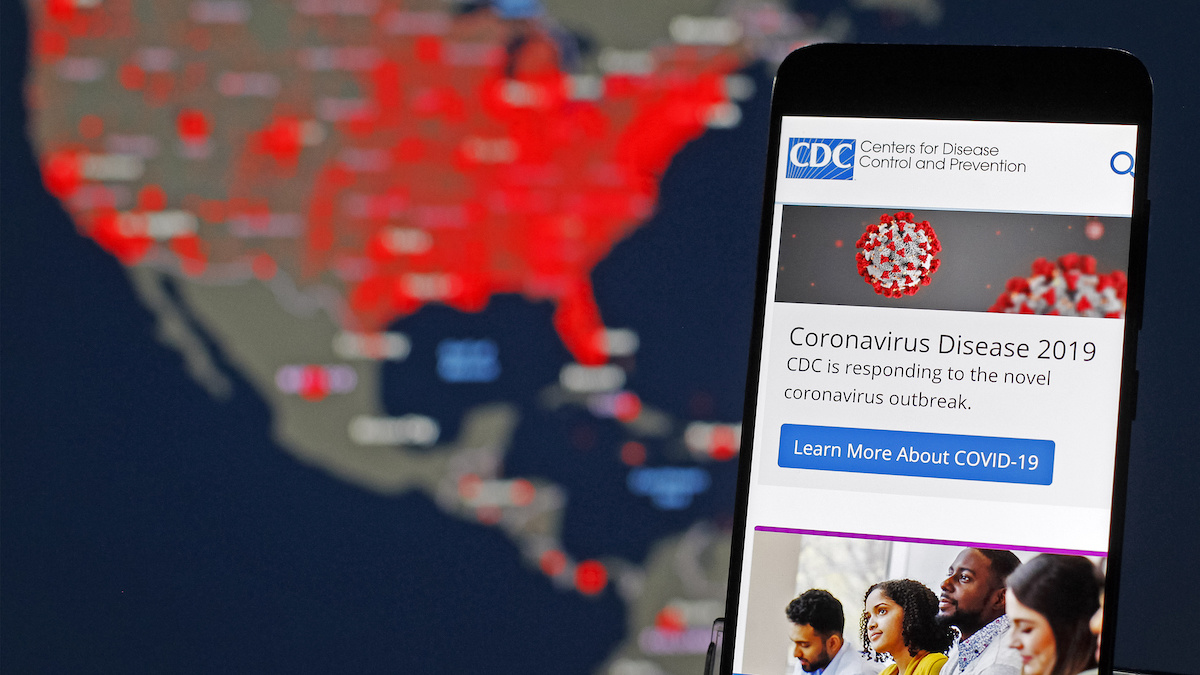

The Centers of Disease Control and Prevention (CDC) web page is displayed on a mobile phone. Pavlo Gonchar / SOPA Images / LightRocket via Getty Images
The backlash to the U.S. Department of Health and Human Services (HHS) order for hospitals across the country to stop reporting data to the CDC and instead send their data to a private contractor was fast and furious.
In the lead-up to the implementation of that order, which goes into effect today, the Centers for Disease Control and Prevention (CDC) removed coronavirus tracking data from its website, prompting an outcry that forced HHS to put the data back up on its site, as The Washington Post reported.
On Thursday, governors from across the country added their voices to the groundswell of objections to the plan and the abruptness of the change to the reporting protocols for hospitals, according to The Washington Post. They asked the administration to delay the shift for 30 days. In a statement, the National Governors Association said hospitals need the month to learn a new system while simultaneously handling the pandemic.
Democrats have accused the administration of seeking to subvert the CDC and potentially manipulate coronavirus findings.
“I don’t know why the White House is saying they want to hide the numbers, but it makes no sense in terms of fighting this crisis,” Senate Minority Leader Chuck Schumer (D-N.Y.) said on Thursday, as POLITICO reported.
The maneuver seems like an attempt by the Trump administration to shift blame for the mismanagement of the coronavirus to the CDC. In addition to governors rebelling, the medical community was appalled that the CDC would be sidelined.
“Placing medical data collection outside of the leadership of public health experts could severely weaken the quality and availability of data, add an additional burden to already overwhelmed hospitals and add a new challenge to the U.S. pandemic response,” said Thomas File Jr., president of the Infectious Diseases Society of America, in a statement, as The Hill reported.
That is when HHS directed the agency to put the information back up on its website.
“HHS is committed to being transparent with the American public about the information it is collecting on the coronavirus. Therefore, HHS has directed CDC to re-establish the coronavirus dashboards it withdrew from the public on Wednesday,” Assistant Secretary of Public Affairs Michael Caputo said Thursday, as CNN reported.
“Going forward, HHS and CDC will deliver more powerful insights on the coronavirus, powered by HHS Protect,” said Caputo. HHS Protect is the department’s coronavirus information center.
CDC officials were reluctant to maintain the dashboard if they were no longer receiving first-hand information. The dashboard shows the number of people with COVID-19, the number affected by SARS-COV2 (the virus that causes COVID-19) and hospital bed capacity. The CDC dashboard states that its information comes directly from hospitals and does not include data submitted to “other entities contracted by or within the federal government.” It also says the dashboard will not be updated after July 14.
“This file will not be updated after July 14, 2020 and includes data from April 1 to July 14,” the CDC said, as CNBC reported.
The website directs users to the HHS new guidelines for reporting data.
As The Washington Post noted, the CDC site had been one of the few public sources of granular information about hospitalizations and ICU bed capacity. About 3,000 hospitals, or about 60 percent of U.S. hospitals, reported their data to the CDC’s system.
Now the new requirements have hospitals and state officials in a bind. At least some state health departments that have been collecting data for their hospitals and sending it to Washington have already said the switch will make it impossible for them to continue, at least for now, according to The Washington Post.
The changed protocol includes a requirement that hospitals send several additional types of data that some state systems are not equipped to handle, state health officials said, as The Washington Post reported.
The reporting change “is a heavy lift for hospitals,” said Charles L. Gischlar, spokesman for the Maryland Department of Health to The Washington Post. He added that the new system “exceeds the capacity of the current statewide system.”
- Trump Admin Rejects CDC Reopening Guidelines - EcoWatch
- Coronavirus and the Terrifying Muzzling of Public Health Experts ...
- Trump Orders Hospitals to Stop Sending COVID-19 Data to CDC ...
- CDC Tells States to Prepare for a Vaccine Before November Election - EcoWatch
- Trump Denies CDC Director's 2021 Timeline for Coronavirus Vaccine - EcoWatch

 233k
233k  41k
41k  Subscribe
Subscribe 